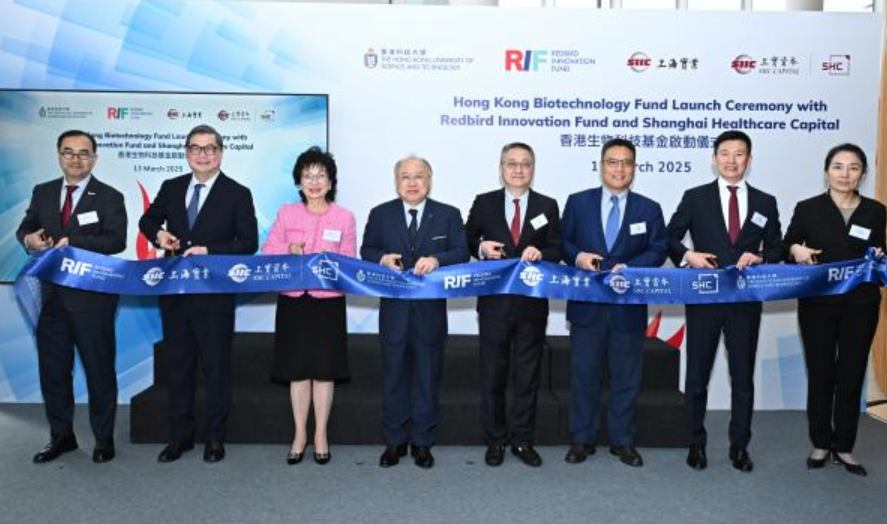HKUST partners SIIC to launch Hong Kong biotechnology fund

The Hong Kong University of Science and Technology (HKUST) and Shanghai Industrial Investment (Holdings) Co., Ltd. (SIIC) have announced the establishment of the Hong Kong Biotechnology Fund (HKBF) to foster innovation in the life sciences sector.
The duo said in a statement on last Thursday that with HKUST and SIIC committed as the anchor investors with a target fund size of HK$600 million ($77.2 million), at least half of the fund is dedicated for ventures associated with HKUST, including start-ups founded by HKUST members, those utilizing HKUST technologies, or incubated within HKUST’s state-of-the-art facilities.
In alignment with the government’s vision in developing Hong Kong as an International Health and Medical Innovation Hub, the HKBF is designed to nurture healthcare technology starts-ups from HKUST and the broader industry, said the statement.
As the inaugural venture investment fund (VIF) under the Redbird Innovation Fund (RIF) framework, HKBF aims to create a synergistic ecosystem that converts cutting-edge innovations in life sciences into impactful biomedical and healthcare breakthroughs, ultimately benefiting global health.
“As the first partner of RIF, SIIC Capital has a proven track record of early-stage biomedical start-ups investment, incubation, and commercialization of cutting-edge medical technologies,” said Edith SHIH, HKUST Council Vice-Chairperson and RIF Chairperson.
“We believe that our partnership with SIIC Capital will drive advancements in biotechnology, life science and healthcare industries,
“By bridging academia and industry, we aim to make life-saving technologies more accessible and affordable — a commitment to our responsibility to society,” she added.
Meanwhile, HKUST Acting President Prof. Tam Kar-Yan said the university’s ecosystem has spawned over 1,800 active start-ups, including ten unicorns and 11 initial public offerings (IPOs), providing that world-class research directly catalyzes economic and technological progress,” he said.
According to him, this fund addresses the pressing challenge of an aging population by accelerating the commercialization of biomedical breakthroughs, from artificial intelligence (AI)-driven diagnostics to sustainable therapies.
“Together with partners like SIIC and Shanghai Healthcare Capital (SHC), we are building an ecosystem where research transcends laboratories to heal communities and transform lives,” he added.
The Under Secretary for Innovation, Technology and Industry Lillian Cheong Man-Lei said the launch of the Hong Kong Biotechnology Fund aligns much with the government’s calls to foster closer collaboration among industry, academia, research and investment sectors, and to channel more market capital to support the development of specified emerging and future industries.
She believed that the fund would help strengthen the connections between HKUST start-ups, industry partners, medical practitioners, and healthcare investors, levering the resources and maximizing the value of Hong Kong’s healthcare ecosystems.
“The government greatly supports the development of technology industries with an edge and of strategic importance, and life and health technology is one of the key focuses,
“The government will further capitalize on Hong Kong’s strengths in basic research and foster more global innovation and technology (I&T) collaboration, with measures such as the HK$6 billion ($771.95 million) subsidy program to support setting up of cross-institutional and multidisciplinary life and health technology research institutes in Hong Kong, the allocation of HK$2 billion ($257.31 million) to support the InnoHK research clusters to establish presence in the Hong Kong-Shenzhen Innovation and Technology Park (HSITP), etc. to help cultivate in Hong Kong a robust life and health technology ecosystem,” she aded.
According to the statement, management of the HKBF will be entrusted to SIIC Capital, which will implement proactive investment strategies and oversee application procedures.
SIIC Capital has already identified a robust pipeline of diversified opportunities across various biomedical sectors, such as neurodegeneration, ophthalmic drug delivery system, and gene therapy.
As the fund progresses, SIIC Capital anticipates discovering even more promising ventures and actively seeking potential investors to amplify the total fund size.
“The HKBF accelerates Shanghai-Hong Kong collaboration by translating academic breakthroughs from local universities into industrial applications,
“Through aligning research and development (R&D), production and capital resources globally, we empower pioneering innovations to reshape healthcare ecosystems,” said Zhang Qian, Shanghai Industrial Investment (Holding) Co., Ltd President.
Hong Kong Biotechnology Fund President May Liang said that with the launch of the HKBF, SIIC Capital will leverage its industrial ecosystem capabilities and Shanghai-Hong Kong synergies to target early-stage biotech R&D translation.
“Guided by the dual engines of ‘Science + Industry,’ we prioritize HKUST-led disciplines to accelerate commercialization of breakthrough innovations,
“Leveraging SIIC Capital integrated ecosystem spanning industry, academia, and healthcare, the fund will drive strategic partnerships to advance Hong Kong’s global innovation hub vision and fuel transformative healthcare advancements,” she added.
#HKUST #BiotechnologyFund #HealthcareInnovation #LifeSciences #StartupInvestment
- Art
- Causes
- Crafts
- Dance
- Drinks
- Film
- Fitness
- Food
- Games
- Gardening
- Health
- Home
- Literature
- Music
- Networking
- Other
- Party
- Religion
- Shopping
- Sports
- Theater
- Wellness


